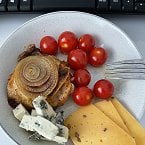Easter preparation
Preparations for Easter begin a week in advance, which is called Passion or White. On Maundy Thursday, it was customary to clean the house, decorate the icons with festive towels, and it was also necessary to bathe the whole family before sunrise in running water, supposedly washing away all sins and illnesses from a person.
On Thursday, the housewives began to prepare the main dishes of the Easter table: ritual bread, painted or painted eggs, an Easter basket for consecration in the church.
This was followed by Good Friday - this is the strictest day of fasting in the annual cycle of worship. On this day, you also need to attend worship. Saturday is considered the day of rest, the transition from the Passion of Christ to the Bright Resurrection of Christ. It is on Saturday evening that the night service begins, at which Easter baskets are taken for consecration.
paska
By tradition, pasca is baked on Thursday, because doing it on Friday is considered a great sin. They say that if you bake paska on Friday, it will not rise, and this will have a negative impact on the future of the whole family: during the year, the family will be haunted by failures and even one of the relatives will probably die.
Paska is made from the best flour, adding raisins, vanilla and cinnamon to it, two dozen eggs are driven in so that the dough becomes yellow. During the preparation of pasta dough and during baking, it is strictly forbidden to walk past the oven, knock, slam the door, talk, because the slightest draft can prevent the dough from rising well. They also believed that a woman should stay alone in the house and pronounce various verbal formulas, such as: “Go, Satan, out of the house, because I will plant Easter cake” and be sure to cross the Easter cake.
It is considered a very good omen if the cake turns out high and bakes well. It symbolizes the happiness and well-being of the whole family.
When the paska was ready, they began to decorate it. From above, Easter cake was decorated with flowers made of dough, figurines of birds and spirals - a symbol of the sun. It is customary to make five to ten paskas in order to subsequently treat all relatives and friends, congratulating them on Easter.
painted eggs
Another special tradition was the coloring of eggs. Since ancient times, painted eggs have been considered a symbol of the rebirth of life, nature and the sun. Previously, eggs were painted using natural materials. They used homemade paints from the bark and fruits of trees, herbs and flowers. Each type of egg decoration got its own name.
Easter basket
The church was sure to collect an Easter basket. Usually its content differs from the region of Ukraine and has its own characteristics. Only paska remains unchanged attribute. In addition to pasok, in Central Ukraine they put Easter eggs in the shell in the basket, and in Galicia they cleaned them. In the Hutsul region, the water in which eggs were boiled was consecrated: according to legend, if a person washes his face with this water, his face will be clean and healthy. In some regions, they also consecrated water with red Easter eggs, so that later they could wash their faces for beauty.
The basket includes sausage, bacon, bread, butter, and cheese, as well as items such as crosses, medallions, icons, and a variety of amulets. The top of the basket is covered with a towel.
Quick Search

Prices & Services
Letters from 2$
Fast Gift Delivery
2-way Video Chat
5 Membership Levels
View all rates
